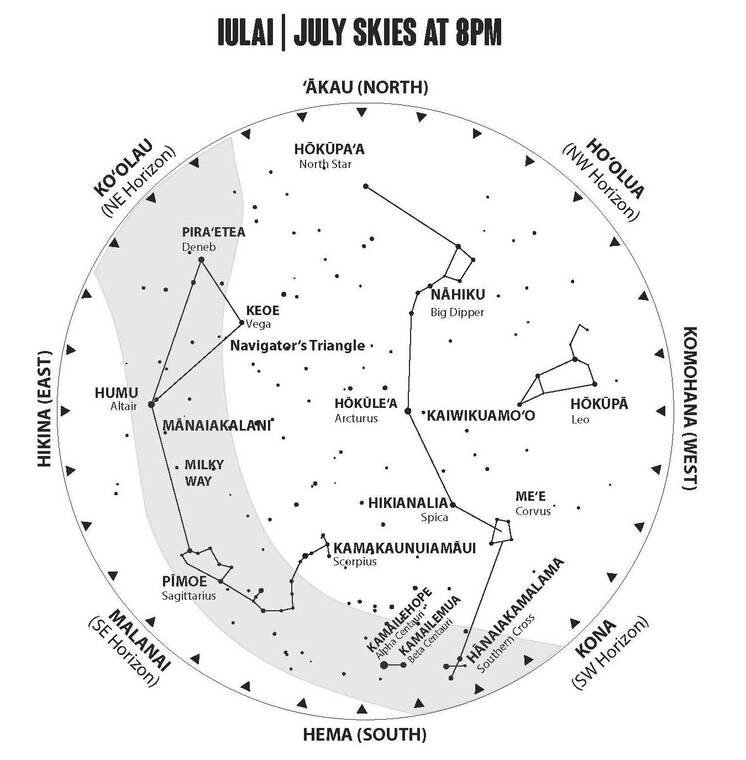
Mahalo for supporting Honolulu Star-Advertiser. Enjoy this free story!
Special events
On July 13, the full moon will take place while the moon is at perigee, the point of the moon’s orbit when it is at its closest position to Earth.
When the moon is full or close to perigee, the moon appears slightly bigger and brighter in the sky. This event is often called a supermoon. Supermoons can be up to 15% brighter than an average full moon.
There also is a unique astronomical phenomenon that occurs in Hawaii because the islands are in the tropics. Fondly known as Lahaina noon, this phenomenon refers to the days when the sun passes exactly overhead during solar noon; at this time objects with smooth sides will appear to cast little or no shadow.
These events can only be observed in the tropics and your latitude within the tropics will affect when the Lahaina noon will occur.
In Honolulu, Lahaina noon will take place at 12:37 p.m. July 15 and 26. Hilo’s will occur at 12:26 p.m. July 23.
Evening observations
In the early evening hours we will be able to view two of our Hawaiian navigational starlines. Kaiwikuamo‘o will still be stretching over our heads connecting the North Star, Hokupa‘a, down to the Southern Cross, Hanaiakamalama. July is the last month this year in which we can see the Southern Cross in our early evening sky. At the same time, our summer starline, Manaiakalani, will be rising in the eastern sky.
Views of the Milky Way are spectacular during the summer months in Hawaii. In the early evening, when we look toward the shape of Kamakaunuiamaui, also known as Maui’s Fishhook, we see an area of the Milky Way band commonly called the bulge, which refers to the central regions of the Milky Way.
The Milky Way band is illuminated by the combined light of millions of stars, most of which are too far away for us to see with our naked eye. However, a small telescope or even a pair of binoculars will allow us to see many stars in the Milky Way band, especially on clear, moonless nights with little light pollution.
Morning observations
Early-bird stargazers will enjoy a very different perspective of the night sky.
Throughout July, the sun will rise around 6 a.m. and the light of dawn will color our sky starting just before 5:30.
The march of the planets will continue across the early morning sky. For the first week of July, all five planets that are visible to the naked eye — Mercury, Venus, Mars, Jupiter and Saturn — will be in the sky at the same time, around 5 a.m.
Mercury will be the most difficult to spot as it will stay close to the horizon as the sun rises.
Venus, on the other hand, will be the brightest object in the sky and will stand out against the background of the constellation Taurus and the Hyades star cluster. Mars and Jupiter; meanwhile, will be higher up in the southeastern sky with Saturn beginning to tilt down to the southwest.
These five planets are historically counted among the so-called luminaries, seven celestial objects that we observe moving across the sky against the backdrop of the stationary stars. The other luminaries are the sun and the moon.
The tracking of these celestial objects dates back as early as the records of Babylon. The seven luminaries were so important to the people of the past that they are responsible for our seven-day week, with each day honoring a luminary.
Featured Mauna Kea discovery/observation
Neptune and Uranus, the twin ice giants of the outer solar system, are often confused with one another. After all, both planets are roughly the same size and mass, and they share many of the same gases that make up their respective atmospheres. These gases are what creates the unique coloration of each world.
The fact that they share so many similar physical characteristics inevitably leads to some confusion about which planet is which.
An international team of astronomers, using ground- and space-based observatories, has been studying the atmospheres of both planets to ascertain why, exactly, the atmospheres of the two worlds differ. The answer lies in complex computational models of each planet’s atmosphere.
The study was made possible by combining the efforts of three very different instruments.
NASA’s Infrared Telescope Facility and the Gemini North telescope, both situated atop Mauna Kea, joined forces with the observational might of the Hubble Space Telescope to produce an atmospheric model that can be applied to both planets. This impressive combination of multiwavelength observations helps us understand why, when the two planets share so many characteristics, they are so different in color.
A planet’s color may sound like a rather trivial point of interest; however, color is often indicative of physical characteristics such as the presence of complex chemistry, weather patterns and temperatures. In the case of rocky terrestrial planets, color can tell us about the ecological and geological conditions of a world. Take the Earth, for example: From space we can observe the tans of deserts, the blue-greens of the oceans, the green of vegetation and crops, and of course, the white of ice and clouds.
The data collected and modeled for the two ice giants allows us a glimpse into the interiors of these planets. By studying the light that is reflected at different wavelengths we can ascertain details that lie hidden to the human eye.
The reflective properties of the atmosphere of Uranus indicate to us that the planet’s pale color is due to the presence of a thick haze located in the middle layers of the planet’s atmosphere. This haze is composed of aerosols, and it is probably not too dissimilar from the haze we sometimes see here on Earth that is associated with forest fires, smog and mist.
By studying color and reflectivity properties we can better understand the weather systems on other planets — and not just the planets of our own solar system. Observations of exoplanet atmospheres, the atmospheres of planets around other stars, benefit directly from the knowledge gleaned from studying our own solar family.
By analyzing the reflectivity of exoplanet clouds, we can begin to understand what those alien planets are like and assess their potential habitability.
We can search for potential biomarkers, or indicators of potential life such as water and molecular oxygen. This knowledge allows us to better refine our methods of searching for life in the cosmos and helps us to seek out life on these strange new worlds.
Skywatch July 2022 by Honolulu Star-Advertiser
The ‘Imiloa Astronomy Center of Hawaii is a center for informal science education at the University of Hawaii at Hilo showcasing astronomy and Hawaiian culture as parallel journeys of human exploration.
Source: Star Ads





